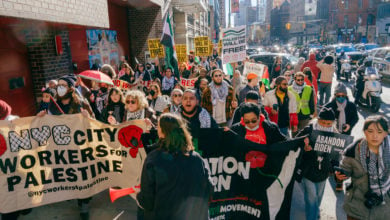How many times does Israel have to apologize for massacring civilians in the same town before the apology rings hollow? For the second time in ten years, the Israeli military has carried out a horrific massacre in the southern Lebanon town of Qana. The second mass killing was no more of accident than the first. Both, like the 1982 massacres in the Sabra and Shatila Palestinian refugee camps of West Beirut, were conducted with cool deliberation. All had clear and decipherable tactical objectives.
It was no coincidence that the massive Israeli ground offensive in southern Lebanon followed immediately on the
 |
In April 1996, Israel still occupied much of Lebanon’s south as it had since 1978. That month, Israeli air force bombing and artillery shelling drove 500,000 Lebanese from their homes. More than 800 people fled to a United Nations refugee center in Qana. The center was unmistakably marked and well known as a UN refugee facility. Yet, on April 12, 1996, Israel artillery fired on the camp with anti-personnel shells. The proximity fuse shells exploded several meters above the ground, spraying razor sharp metal and bomblets that cut any living being in their path to pieces.
An Israeli spotter plane and two helicopters flew over Qana before, during and after the shelling. When it stopped, at least 105 people—half of them children—lay dead. More than 120 people were wounded. All the dead and wounded were civilians—women, men and children, young and old. While Madeleine Albright, then-president Clinton’s ambassador to the UN, was able to veto yet another condemnation of Israel at the UN Security Council, much of the world was outraged by the wanton Israeli attack.
It wasn’t just pervasive racist contempt for Arab lives that led to the Israeli Occupation Forces’ action that day in 1996. It was an intentional act of terror meant to traumatize the survivors and the population as a whole. The idea was to force the people of occupied south Lebanon to surrender and accept the rule of Israel and its puppet regime in the region. The tactic failed. Popular support for Hezbollah grew and four years later Israel was forced to withdraw from most of Lebanon. Several investigations concluded that the attack on the camp was deliberate.
Who is really targeting civilians?
The 2006 Qana massacre was intended to force an exodus of the remaining population from southern Lebanon in order to clear the way for an offensive by 10,000 Israeli troops, tanks and Caterpillar armored bulldozers, backed by aerial and artillery bombardment. In order to further “encourage” the population to flee, the Israeli government announced a 48-hour “suspension” of its bombing. There was, however, no bombing halt, and many more Lebanese were killed or wounded as they headed north after the “suspension” was announced.
On Aug. 2, AFP reported that at least 835 Lebanese have been killed and more than 3,000 wounded during the past three weeks; most were victims of Israeli bombing and shelling. The same day, Israeli prime minister Ehud Olmert proclaimed that one of Israel’s “achievements” in the fighting was creating an immense exodus of Lebanese refugees, who now number more than 750,000, or about 20 percent of the country’s population.
In Gaza and the West Bank, more than 140 Palestinians have been killed in the past month. On the Israeli side, the death toll is 55 in the war with Lebanon, 36 of them soldiers. Israel says that one soldier has died in Gaza, reportedly due to “friendly fire.”
Statistics give the lie to repeated claims by the allied U.S. and Israeli governments that Israeli is “taking care to minimize civilian casualties,” while Hezbollah is “deliberately targeting civilians.” Well over 90 percent of Lebanese casualties over the past three weeks, as compared to 34 percent of Israeli losses, have been civilians.
U.S., Israel block immediate ceasefire, widen war
While they have inflicted heavy casualties and massive destruction on the Lebanese people, the war has not gone well for the U.S.-Israeli side. Israel has a huge advantage in military weaponry. Hezbollah has no planes, no tanks, no ships, no cluster or white phosphorous bombs.
While the pro-war media here constantly alleges that Hezbollah is supplied by Syria and Iran, almost never mentioned
|
The United States is the world’s top military power. Israel, despite its small size, is ranked fourth or fifth in the world due to massive U.S. aid. Despite facing such an array of power, the Lebanese resistance forces have fought with great determination and effectiveness. The last time Israel invaded Lebanon in 1982, its troops had occupied Beirut and two-thirds of the country within two weeks. Not so in 2006.
The United States and Israel have refused international calls for a ceasefire. Bush and his advisors have constantly reiterated their position that there must be a “sustainable peace.” What he means by this is no secret: Hezbollah and all Lebanese resistance forces must be destroyed. If they are not, and if a settlement is negotiated that leaves the resistance forces relatively intact, it would represent defeat for both Washington and Tel Aviv.
Israel’s air war, with its thousands of bombing runs, has wreaked enormous destruction all across Lebanon, but it has not defeated the resistance. Not only that, the Lebanese population is more united now than at any time in history—in support of the resistance. A recent poll showed that more than 80 percent of Lebanese Christians—historically a more conservative element of the populace in this extraordinarily diverse country—now support Hezbollah. Outside of Lebanon in the Arab and Islamic world, support for Hezbollah and its leader, Sheik Hassan Nasrallah, has soared, a very worrying development for pro-U.S. regimes in Jordan, Egypt, Saudi Arabia and elsewhere.
These factors have only served to harden the determination of both U.S. and Israeli leaders that Hezbollah must be decisively defeated. The aim of the massive ground offensive now underway is to crush the resistance and set the stage for the insertion of an imperialist “peace-keeping” force in southern Lebanon.
At the same time, voices inside both the Israeli and U.S. ruling circles are demanding a further widening of the war, calling for attacks on both Syria and Iran. The advocates of a “final conflict” strategy believe that only regime change in Damascus and Tehran can bring about their desired objective of U.S. hegemony over the entire oil-rich and strategic region.
The Aug. 1 assault by Israeli commandos on Baalbeck, only 10 miles from the Syrian border, was a provocation, as was the bombing of a Lebanese-Syrian border crossing the same day.
The toll of death and destruction and the looming danger of a wider war underline the critical importance of the Aug. 12 mass demonstrations in Washington, D.C., Los Angeles, San Francisco and other cities.







